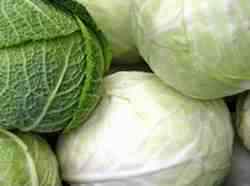Farm Update
 |
| The cherry tomatoes are ripening nicely now that it is a little warmer. |
What to Expect in Your Share This Week
At the regular drop-offs:
- Choice of snap beans, broccoli, or leeks
- Choice of cherry tomatoes or apples
- Choice of kale or Swiss chard
- Choice of beets or cabbage
- Choice of zucchini or basil
- Choice of head lettuce, spring mix, or a bag of small storage onions
- Choice of tomatoes, cucumbers, or shallots
For home/workplace delivery:
A Share: B Share:
Snap beans Broccoli
Cherry tomatoes Cherry tomatoes
Kale Swiss chard
Zucchini Basil
Lettuces Lettuces
Cucumber Slicing tomato
Beets Cabbage
Veggie Spotlight: Cabbage
 Southern Fried Cabbage: This is pretty similar to one of our favorite ways of making cabbage at home, but I'd use olive oil instead of vegetable oil.
Southern Fried Cabbage: This is pretty similar to one of our favorite ways of making cabbage at home, but I'd use olive oil instead of vegetable oil.
 Healing Cabbage Soup: As the weather gets cooler, soups are an awesome comfort food! Check out this cabbage soup recipe, but feel free to switch out the chicken bouillon for a more natural alternative like chicken broth or stock, and adjust the amount of water accordingly.
Healing Cabbage Soup: As the weather gets cooler, soups are an awesome comfort food! Check out this cabbage soup recipe, but feel free to switch out the chicken bouillon for a more natural alternative like chicken broth or stock, and adjust the amount of water accordingly.
 |
| Savoy and green cabbages |
Every year there are certain crops that do especially well, as
the particular weather conditions of a given season favor certain veggies. This year’s ridiculously productive veggie is
cabbage, which has really done well under temperatures and rainfall that have
been optimal for cabbage almost the entire summer.
Cabbage is recorded as being eaten since around 1000 BC, but
like many vegetables, it has changed quite a bit over that time. The first
cabbage plants were thought to have originated in the cooler northern parts of
Europe. These first early cabbages were actually very loose and leafy, more
similar to kale, and were mentioned frequently in Roman writings. It was
possibly as early as 200 BC that the heading types started to appear, but this
is still unclear.
 |
| I love the vibrant color of red cabbages! |
In medieval times, the cabbage was more associated with
the European peasants, for whom it was a large part of their diet. Because
cabbage is generally hardier than most other crops, European peasants could
count on there being cabbage to eat even when weather events caused other crops
to fail. The first recorded account of Savoy cabbage was from when
Catherine di Medici married Henri II of France and brought Savoy cabbage to France
with her, though it is widely thought to have been developed somewhere in
Germany. In the next couple of centuries, cabbage started to become more
prominent on long voyages as sauerkraut. This was because of the ability
to preserve the vitamin C in the cabbage, which would prevent scurvy. Every year we give a bunch of cabbage to our
neighbor who makes a similar traditional sauerkraut for both of our families
and a few friends.
At our farm we grow red,
Savoy, Napa, and our favorite “Tendersweet” cabbage, which is green and flat.
We start the plants by seeding them in flats in the greenhouse, where they grow
for four or five weeks before we transplant them into the soil. In the
spring, we mostly raise them on beds covered with black plastic, thus keeping
the leaves cleaner to help ward off soil-borne diseases. The plastic also
warms the cool spring soil to get the plants growing faster. These
cabbage plants are heavy feeders and require a lot of soil fertility. We
give them slightly less fertility than recommended so we can keep the heads
more of a reasonable size for the average household, but after five years of building
our soils and the optimal weather we’ve had this season, they have still gotten
pretty large. The largest cabbage record
in the Guinness Book of World Records is 127 pounds!
 |
| Lifting a bunch of cabbages is one of the hardest parts of the harvest process, so we often use the tractor to help. |
Harvesting cabbage is a lot less
complicated than many other crops. We just cut the head off with a knife
after the head is nice and firm, and then trim off some of the outer
leaves. The worst thing about this otherwise easy harvest is just lifting
so many heavy crates of cabbage! We do use the forks on the tractor this season
to help move cabbage, especially with the large size this season.
At home our favorite cabbage
dish is fried cabbage with bacon and tomato, a little cheese, onion (shallot is
even better), and cayenne pepper. We sometimes also make sauerkraut by adding
salt and letting the cabbage and salt ferment. This traditional method of
making sauerkraut is a much healthier way than the vinegar method most common
today. The salt preserves the vitamin C, and also leaves a
beneficial salt-tolerant bacteria that is very helpful in digestion. Kimchi is a great way to eat and preserve either
Napa or the Savoy cabbage and the right recipe is very addicting. Fred’s parents
also freeze a lot of the Tendersweet cabbage for the winter by just slicing it
up and putting it in zippered freezer bags.
So if you get a little more cabbage than you will use in the next week,
this is a good option.
This week in the shares
you folks will have the option of red, Savoy, Tendersweet, and Napa cabbage.
There are a lot of delicious things to do with cabbage, so if you need ideas,
check out the recipes below!
Recipes
 Southern Fried Cabbage: This is pretty similar to one of our favorite ways of making cabbage at home, but I'd use olive oil instead of vegetable oil.
Southern Fried Cabbage: This is pretty similar to one of our favorite ways of making cabbage at home, but I'd use olive oil instead of vegetable oil. Healing Cabbage Soup: As the weather gets cooler, soups are an awesome comfort food! Check out this cabbage soup recipe, but feel free to switch out the chicken bouillon for a more natural alternative like chicken broth or stock, and adjust the amount of water accordingly.
Healing Cabbage Soup: As the weather gets cooler, soups are an awesome comfort food! Check out this cabbage soup recipe, but feel free to switch out the chicken bouillon for a more natural alternative like chicken broth or stock, and adjust the amount of water accordingly.
No comments:
Post a Comment